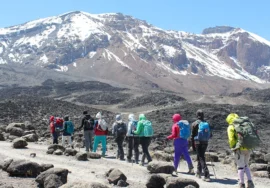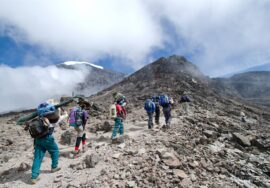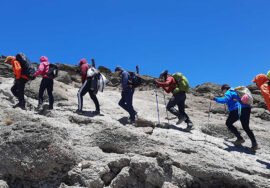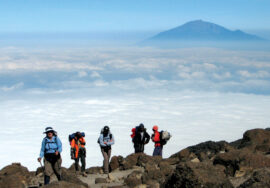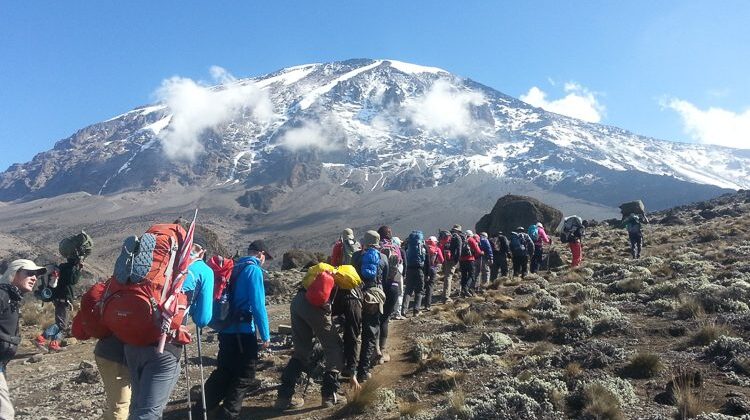
Machame Route | Mount Kilimanjaro Hike
Machame Route | Mount Kilimanjaro Hike.
DAY 1
Starting at Machame Gate (1,800 m.), the climb goes along a hill through thick mountain forest. In this part of the mountain, there are the most trees, and this is also where 96% of Kilimanjaro’s water comes from. This part of the trail is very green and beautiful on sunny days, especially during the dry season. It can be very muddy, though, especially after it has rained recently. We eat lunch at “Halfway Clearing,” a small hole in the trees, and then keep slowly climbing. The slope gets less steep as you get closer to the next camp, which is near the ruins of Machame Hut (3,000 m). The forest slowly turns into giant heather. If the clouds clear in the evening, we might get our first good look at Kibo’s glaciated cap. [walk for 6 to 8 hours]
DAY 2
A shorter day that starts with a climb up a steep hill to Picnic Rock, a small cliff that is shaped like a half-circle. From here, you can see Kibo and the rough edge of Shira Plateau very well. It’s also a nice place to rest. To get to the Shira Plateau, the road keeps going that is less steep. We camp near Shira Hut (3,840m), which has some of the most beautiful views on Kilimanjaro. It faces the huge volcanic cone of Kibo and the beautiful rock formations of Shira Plateau. Across the way, Mt. Meru appears to be floating on the clouds. [4 to 6 hours of walking]
DAY 3
In the morning, there was a gentle climb with great views. We left the moorland area and walked on lava ridges below the Western Breach glaciers. After lunch near the Lava Tower junction (4,550 m.), we go down to the bottom of the Great Barranco valley (3,900 m.), where tall cliffs protect us and give us a wide view of the fields below. (5–7 hours of walking)
DAY 4
We have to climb steeply up the Barranco Wall to get to a trail that goes along the southeast side of Kibo. This trail has great views of the Southern Icefields. In places where they are protected, the ground turns to scree, and there are pockets of lush foliage. Our camp is only a short distance away at Karanga (4,000 m), which is the last water source on the way to Barafu and is in a narrow valley. You can take it easy or go for a short walk in the afternoon up the valley above the camp to get used to the altitude. (4–5 hours of walking)
DAY 5
From Karanga, there is a short but steep climb up to Mweka Junction (4,150 m.), where there is an easy walk on packed scree with great views. Once we get to the Barafu campsite (4,600 m.), we keep going up until we reach the plateau at the bottom of the South-East valley (4,800 m.). The rest of the day is spent resting to get ready for the last climb, which starts early in the morning. (4–5 hours of walking)
DAY 6
We will begin our climb by flashlight around 1 a.m. so that we can reach the edge of the Crater by morning. We will get to Stella Point (5,735 m.) in about five or six hours if we keep a slow but steady pace as we climb steeply over loose volcanic scree. We’ll take a short break there to watch the sun rise over Mawenzi.
From here, it takes two hours to go around the crater rim and reach Uhuru Peak (5,896 m). Along the way, you’ll get to see the beautiful glaciers and ice walls that still cover most of the summit area. It’s amazing how quickly we can get down to Barafu. After a break to refuel, we keep going down until we reach our final campsite, Millennium, at 3,800 meters. The forest around the busy campsite is beautiful, but most of us will be too tired to notice it. (11 to 15 hours walking)
DAY 7
A steady descent on a well-built road through a beautiful tropical forest full of birdsong and lush undergrowth with lots of interesting plants. Our path makes its way down to the National Park gate at Mweka, which is 1,650 m below us. Here is where we leave the national park. We then walk for another 15 minutes through coffee and banana farms to get to Mweka town, where our car is waiting. There is a shower, drink, and a swimming pool very close by. [4 to 6 hours of walking]
It’s not just Tanzania that we know!
If you want to know more about Tanzania, the best thing to do is call us during business hours. We really enjoy Tanzania, but we also really enjoy the rest of Africa. We have experts in all of the big safari countries. If you’re not sure where to go, please email or call us!

